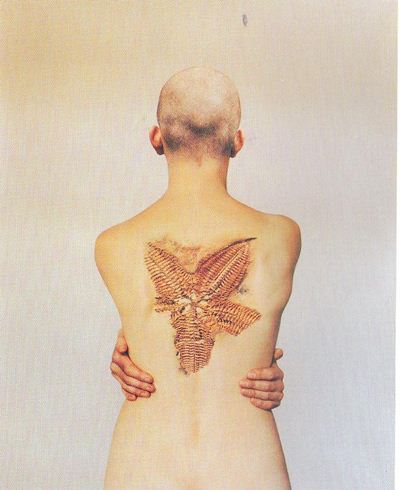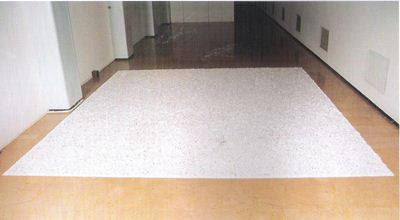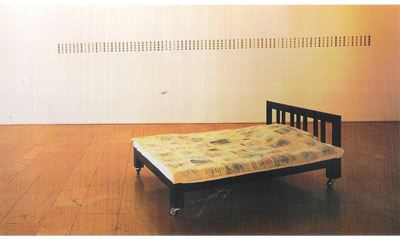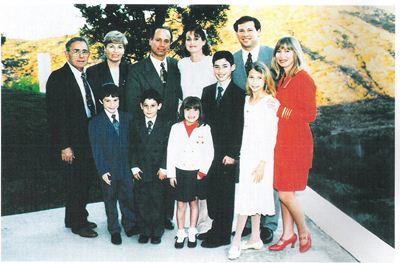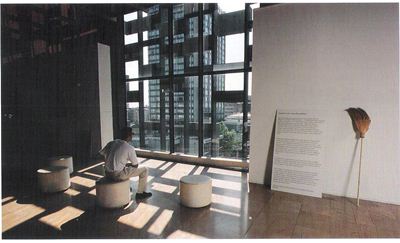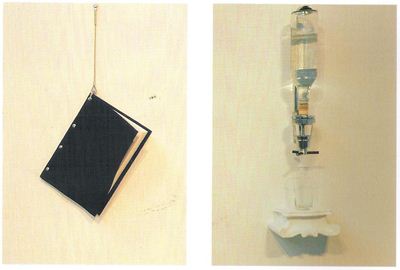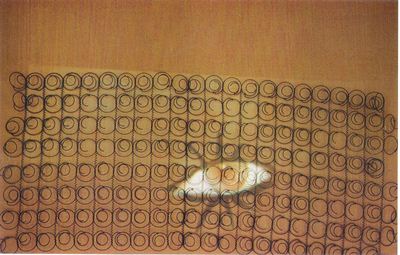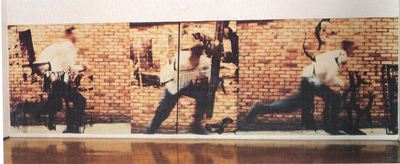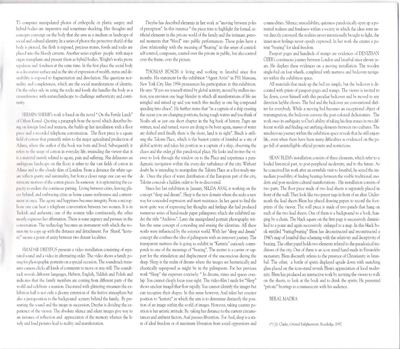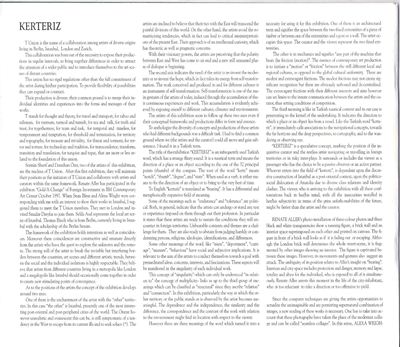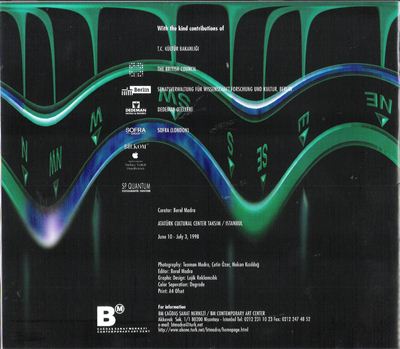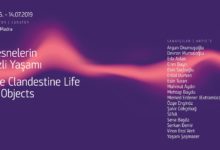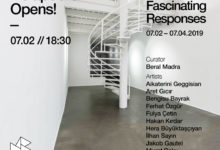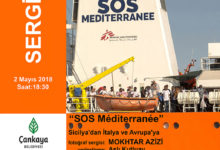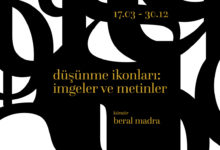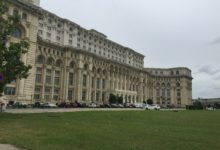KERTERiZ
A T-UNION Exhibition/ Bir T-UNION Sergisi
RENATE ALLER, SELDA ASAL, SEAN BLEM, THOMAS BÜSCH, SMADAR DREYFUS ,DENiZHAN ÖZER SERMIN SHERIF ALEXA WRIGHT
SERGI YAPIMCISI / CURATOR: BERAL MADRA
10 HAZIRAN/ JUNE- 3 TEMMUZ/ JULY 1998
Atatürk Cultural Center/Ataürk Kültür Merkezi
Catalogue Text/Katalog Metni:
T Union is the name of a collaboration among artists of diverse origins living in Berlin, Istanbul, London and Zurich.
This collaboration was born out of the necessity to expose their productions in regular intervals, to bring together differences in order to attract the attention of a wider public and to introduce themselves to the art scenes of distant countries.
This union has no rigid regulations other than the full commitment of the artist during his/her participation. To provide flexibility of possibilities they can expand or diminish.
Their production is diverse; their common ground is to merge their individual identitiesand experiences into the forms and messages of their works.
T stands for thought and theory, for travel and transport, for taboo and talisman, for tantrum, turmoil and tumult, for tea and talk, for truth and trust, for togetherness, for team and task, for temporal and timeless, for temperament and temptation, for threshold and termination, for territory and topography, for treasure and triviality, for threat and torment, for terror and torture, for technology and tradition, for transcendence, transform, transition and translation, for tuqoise and topaz, that are more or less related to the foundation of this union.
Sermin Sherif and Denizhan Özer, two of the artists of this exhibition are the nucleus of T Union, After this first exhibition they will maintain their position as initiators of T Union and collaborate with artists and curators within the same framework. Renate Aller has participated in the exhibiton “Gold-X-Change” of Foreign Investment realized in BM Contemporary Art Center October 1997. When Sean Blem and Alexa Wright were corresponding with me with an interest to show their works in Istanbul, I advised them to meet the T Union members. They met in London and invited Smadar Dreyfus to join them. Selda Asal, represents the local art scene of Istanbul. Thomas Büsch from Berlin is currently living in Istanbul with the scholarship of the Berlin Senate.
The framework of the exhibition holds intentions as well as coincidences. Moreover these coincidences are constructive and emanate directly from the artists who have the quest to explore the unknown and the remote. The strong will of the artist to break the invisible but interfering borders between the countries, art scenes and different artistic trends, between the social and the individual isolations is highly respectable. They believe that artists from different countries living in a metropolis like London and a megalopolis like Istanbul should occasionally come together in order to create new stimulating points of convergence.
As to the positions of the artists the concept of the exhibition develops around two axes.
One of them is the enchantment of the artist with the “other” territories. In this case “the other” is Istanbul, presently one of the most interesting post-oriental and post-peripheral cities of the world. The Orient however unrealistic and evanescent this can be, is still symptomatic of a tendency in the West to escape from its current ills and to seek solace (*). The artists are inclined to believe that their ties with the East will transcend the painful divisions of this world. On the other hand, the artists avoid the romanticising tendencies, which in fact can lead to critical misinterpretations of the present East. Theirs is an intellectual curiosity, which has theoretic as well as pragmatic concerns.
With their visionary powers, the artists are perceiving that the polarity between East and West has come to an end and a new still unnamed phase of dialogue is starting.
The second axis indicates the need of the artist to re-invent the modernity or re-invent the hope, which in fact takes its energy from self-transformation. The work conceived and produced in and for different cultures is an instrument of self-transformation. Self-transformation is one of the main actions of today’s artists induced by the accumulation of their continuous experiences and work. This accumulation is evidently achieved by exposing oneself to different cultures, climates and environments.
The artists of this exhibition seem to follow up these two axis even if their conceptual frameworks and production differ in form and essence.
To anthologise the diversity of concepts and productions of these artists who had different backgrounds was a difficult task. I had to find a common ground where we (the artists and the curator) could all move and gain subsistence. I found it in a Turkish term.
The title of the exhibition “KERTERIZ” is an infrequently used Turkish word, which has a strange flinty sound. It is a nautical term and means the direction of a place or an object according to the one of the 32 principal points (rhumbs) of the compass. The root of the word “kerte” means “notch”, “rhumb”, “degree”, and “state”. When used as a verb, it either means to fix the direction of an object or to bring to the very best of time.
To English “kerteriz” is translated as “bearing”. It has a differential and metaphorically expansive field of meaning.
Some of the meanings such as “endurance” and “tolerance” are political. Both, in general, indicate that the artists can undergo or stand any test or experience imposed on them throughout their profession. In particular it states that these artists are ready to sustain the conditions they will encounter in foreign territories. Unbearable contents and themes are a challenge for them. They are also ready to abstain from judging harshly or condemning persons, religions, ideologies, identifications, and differences.
Some other meanings of the word, like “mien”, “deportment”, “carriage”, “manner”, “behaviour” have social and subjective implications. It is relevant to the aim of the artists to conduct themselves towards a goal with premeditated ideas, concerns, interests, and fascinations. These aspects will be manifested in the singularity of each individual work.
This concept of “singularity”-which can only be understood “in relation to” the concept of multiplicity- links us up to the third group of meanings which can be classified as “structural” as they ascribe “relation” and “connection”. In this exhibition, particularly the way in which the other territory or the public stands or is observed by the artist becomes meaningful. The dependence and the independence, the similarity and the difference, the correspondence and the contrast of the work with relation to the environment might find its location for the viewer.
However there are three meanings of the word which made it a necessity to use it for this exhibition. One of them is an architectural term and signifies the space between the two fixed extremities of a piece of timber or between one of the extremities and a post or a wall. The artist occupies this space. The curator and the viewer represent the two fixed extremities.
The other is in mechanics and signifies “any part of the machine that bears the friction (motion)”. The essence of today’s art production is to initiate a “motion” or “friction” between the still different local and regional cultures, as opposed to the global cultural uniformity. There are modest and extravagant frictions. The modest frictions may not create significant recognition but these are obviously unbound and de-centralised. The extravagant frictions with their different interests and aims however can set limits to the innate communication between the artists and the curator, thus setting conditions of competition.
The third meaning is like in Turkish nautical context and in our case is penetrating to the kernel of the undertaking. It indicates the direction to which a place or an object lies from a vessel. Like the Turkish word “kerteriz”, it immediately calls associations to the navigational concepts, to the far horizons, to the deep perspective’s, to cartography, and to the wandering or observing eye.
“KERTERIZ” is a speculative concept, marking the position of the inquisitive curator and the restless artist navigating or travelling in foreign territories or in risky inter-plays. It surrounds or includes the viewer as a passenger who has the choice to be a passive observer or an active partner. Whoever enters into the field of “kerteriz”, is dependent upon the discursive construction of Istanbul as a post-oriental context, upon the politico-social dislocation of Anatolia due to diverse class relations and identity clashes. The viewer, who is arriving to the exhibition with all these confrontations back in her/his mind, with all the insecurities installed in her/his subjectivity in terms of the grim unfathomabilities of the future, might be fierier than the artist and the curator.
RENATE ALLER’s photo-installation of three-colour photos and three black and white transparencies show a running figure, a brick wall and an interior space superimposed on eachother and printed on canvass. The figure infront of a brick wall looks as if it is fading out or escaping. Although the London brick wall determines the whole street-scene, it is fragmented by other images showing an interior. The fgure is captivated beteen these images. However, its movements and gesture also suggest an attack. The ambiguity of its position relates to Aleer’s insight on “bearing”. Interiors and city-space includes protection and danger, memory and lapse, totality and abyss for the individual, who is exposed to all of it simultaneously. Renate Aller arrests this moment in the life of the city-inhabitant, who is too reluctant to take a direction or too offensive to yield. Since the computer techniques are giving the artists opportunities to actualize the unimaginable and are permitting supernatural combination of images, a new reading of these works is necessary. One has to take into account that these photographs have taken the place of the modernist collage and can be called “seamless collages”. In this sense, ALEXA WRIGHT’s computer manipulated photos of orthopedic or plastic surgery and hybrid bodies are impressive and sometimes shocking. Her thoughts and concepts converge on the body that she uses as a medium or landscape of social and cultural identity. In a series of photos the protective shield of the body is pierced, the flesh is exposed, precious stones, fossils and rocks are placed into the bloody caverns. Another series explore people with major organ transplants and present them as hybrid bodies. Wright’s works prove repulsion and fondness at the same time. In the first place the social body as a decorative surface and as the site of expression of wealth, status and desirability is exposed to fragmentation and dissolution. She questions normality and completeness, which are the social manifestations of identity. On the other side in using the rocks and fossils she handles the body as a crossreference with nature/landscape to challenge authenticity and continuity. SERMIN SHERIF’s work is based on the novel “ On the Fertile Lands” of Orhan Kemal. Quoting a paragraph from the novel which describes being on foreign land and reunion, she builds up her installation with a floor piece and a recorded telephone conversation. The floor piece is a square field of cotton that primarily refers to the major agricultural production of Adana, where the author of the book was born and lived. Subsequently it refers to the usage of cotton in everyday life, reminding the viewer that it is a material mainly related to agony, pain and suffering. She delineates an ambiguous landscape on the floor; it refers to the wast fields of cotton in Adana and to the cloudy skies of London. From a distance the white square reflects purity and minimality, but from a closer range one can see the intricate motives of the cotton pieces. In someway it is epitomizing the capacity to endure the continous parting. Living between cities, leaving places behind, and embracing cities as home causes restlessness and contentment at once. The agony and happiness becomes integrity. From a microphone one can hear a telephone conversation between two women. It is in Turkish and authentic; one of the women talks continuously, the other mostly expresses her affirmation. There is some urgency and pressure in the conversation. The technology becomes an instrument with which the women try to cope up with the distance and detachment. For Sherif, “kerteriz” means a point of unity between two distant localities. SMADAR DREYFUS presents a video installation consisting of separated sound and a video in alternating order. The video shows a family posing for photographic portraits on a special occasion. The soundtrack transmits camera clicks all kinds of comments to mowe or stay still. The soundtrack reveals different languages, Hebrew, English, Yiddish and Polish and indicates that the family members are coming from different parts of the world and celebrate a reunion. Decorated with glittering streamers the exhibition hall is not only a gloomy extention of the festive atmosphere but also a juxtaposition to the background scenery behind the family. By presenting the sound and the image in succession, Dreyfus is dividing the viewer’s experience. The absolute silence and silent images give way to instants of reflection and appreciation of the memory whereas the lively and loud pictures lead to reality and manifestation. Dreytfus has described elements in her work as “moving between poles of perception”. In this instance “ the piece tries to highlight the formal, artificial elements in the private world of the family and the intimate, personal moments that “bleed” into public performances. Those poles have a close relationship with the meaning of “bearing” in the sense of control: self control, composure, control over the private in public, but also control over the frame, over the picture. THOMAS BÜSCH is living and working in Istanbul since five months. His statement for the exhibition “Agent Artist” in PS1 Museum, New York City May 1994 pronounces his participation in this exhibition. He says:” If you see yourself stirred by global activity, moved by endless motion, you envision one huge blender in which all manifestations of life are mingled and mixed up and you watch this medley as one big compound speeding into chaos”. He further states that as a captain of a ship cruising the ocean you are changing positions, facing rough waters and you think of Noahs ark as just one short chapter in the big book of history. Pages are written, read and turned, waves are dying to be born again, masses of water are shifted until finally there is the shore, land is in sight”. Büsch is utilising the Taksim Place, which is the busiest centre of Istanbul as a site of global activity and takes his position as a captain of a ship, observing the chaos and the order of this paradoxical place. He looks and invites the viewer to look through the window on to the place and experience a paradigmatic navigation within the every-day turbulence of the city. Without doubt he is intending to manipulate the Taksim Place as a live-ready-made. Once the place of water distribution of the European part of the city, Taksim conceals a hidden order to be re-discovered. Since her last exhibition in January, SELDA ASAL is working on the concept “sleep and dream”. Sleep is the new domain where she seeks a new way for concealed expression and inert-resistance. In her quest to find the most quite way of expressing her thoughts and feelings she had produced numerous series of hand-made paper palimpsests which she exhibited under the title “Archives”. Later she manipulated portrait photography within the same concept of concealing and erasing the identities. All these works were influenced by the exterior world. With her “sleep and dream” concept she confines the idea of palimpsests with an introvert journey. The transparent mattress she is going to exhibit in “Kerteriz” curiously corresponds to one of the meanings of “bearing”. The matter is a carrier or support for the stimulation and displacement of the unconscious during the sleep. Sleep is the realm of dreams where the images are hermetically and chaotically superposed as might be in the palimpsests. For her previous work “Sleep” she expresses concisely: “ In dreams, times and spaces overlap. You cannot clearly focus your sight. The video-film I made for “Sleep” shows unclear images that flow rapidly. You cannot identify the images but can recognise their shapes. In this sense however, Asal takes her counter position to “kerteriz” in which the aim is to determine distinctly the position of an image within the world of images. However, taking counter position is her artistic attitude. By taking her distance to the current circumstances and ambient factors, Asal pursues liberation. For Asal, sleep is a state of ideal freedom or of maximum liberation from social oppressions and commodities. Silence, unreadability, quietness paradoxically open up a potential realness and frankness within a society in which the ideas were never directly conveyed, the realities never intentionally brought to light, the inner-most feelings never openly expressed. In her work she creates a potent “bearing” for ideal freedom. Passport pages and hundreds of stamps are evidences of DENIZHAN ÖZER’s continuous journey between London and Istanbul since eleven years. He displays these evidences on a mowing installation. The wooden single-bed on four wheels, completed with mattress and bedcover navigates within the exhibition space. All materials that made up the bed are simple, but the bedcover is decorated with prints of passport-pages and stamps. The viewer is invited to lay down, cover himself with this peculiar bedcover and be mowed to any direction he/she choses. The bed and the bedcover are conventional shelter for everybody. While a mowing bed becomes an exceptional object of transmigration, the bedcover conveys the post-colonial dichotomies. The works owes its ambiguity to Özer’s ability of taking his firm stance in two different worlds and finding out unifying elements between two cultures. The mischievous journey within the exhibition space reveals that he still enjoys life, even when there have been many difficulties as evidenced on the pages full of unintelligible official permits and restrictions. SEAN BLEM’s installation consists of three elements, which refer to a loaded historical past, to post-peripheral modernity, and to the future. As he conceived his work after an erstwhile visit to Istanbul, he seized the immediate possibility of finding bearings between the visible traditional, modern and post-modern cultural manifestations . His installation consists of two parts. The floor piece made of two lead sheets is separately placed infornt of the wall. They look like two prayer rugs infront of an altar. Underneath the lead sheets Blem has placed drawing papers to record the footprints of the viewer. The wall piece is made of two panels that hang on each of the two lead sheets. One of them is a background to a book, hanging by a chain. The black square on the first page is successively diminished to a point and again successively enlarged to a map. In this black book entitled “baring/bearing” Blem has deconstructed and reconstructed a 1940’s map of Istanbul thus scheming with the relativity and deceptivity of bearing. The other panel holds two elements related to the paradoxical traditions of the city. One of them is an icon stand hand-made in Einsiedeln monastery. Blem discreetly referes to the presence of Christianity in Istanbul. The other, a bottle of spirits displayed up-side down with matching glass placed on the icon-stand reveals Blem’s appreciation of local modernity. Blem has produced an interactive work by inviting the viewer to walk on the sheets, to look at the book and to drink the spirits. He presented “private” bearings to communicate with his audience.
BERAL MADRA
(*) J.J. Clarke, Oriental Enlightenment, Routledge, 1997
T Union, farklı ülkelerden olan ve Londra’da yaşayan sanatçılar arasındaki bir işbirliğinin adıdır.Bu işbirliği sanatçıların üretimlerini düzenli aralıklarla gösterebilmek, farklılıkları biraraya getirerek daha geniş bir izleyici kitlesinin ilgisini çekebilmek, değişik ülkelerin sanat ortamlarına kendilerini tanıtmak gibi, gereksinimler sonucunda oluşmuştur. Bu birlikteliğin, işbirliğine katılım sırasındaki tam dayanışma dışında, katı kuralları yoktur; grup, olanaklarda esneklik sağlamak için büyüyebilir ya da küçülebilir. Sanatçıların üretimleri farklıdır; ortak yönleri, bireysel görüşlerinin sanatın işlevleri ile birleştirilmesidir.
Serginin iki sanatçısı Denizhan Özer ve Sermin Sherif T Union’un çekirdek grubunu oluşturmaktadır. Renate Aller, daha önce Foreign Investment’in İstanbul’da BM Çağdaş Sanat Merkezi’nde açtığı Gold-X- Change başlıklı sergiye katılmıştı. Sean Blem ve Alexa Wright, serginin küratörüne İstanbul’da sergi açmak istediklerini bildirdiklerinde, küratör bu sanatçıları T Union ile tanıştırdı. Grup, Smadar Dreyfus’u da aralarına alarak Londra’da toplandılar ve birlikte sergi yapmaya karar verdiler. Sergiye yerel ortamı temsilen katılan iki sanatçıdan Selda Asal, Istanbul’da yaşıyor, Thomas Büsch ise Berlin Senatosu bursu ise Istanbul’a geldi. Bu iki sanatçı, T Union ile birlikte çalışmayı kabul ettiler.
Serginin temelinde amaç ve rastlantı yanyana yer almaktadır. Amaç kadar rastlantı da yapıcı özellikler taşımakta ve doğrudan doğruya sanatçıların uzak olanı ve bilinmeyeni keşfetme gereksiniminden doğmaktadır. Sanatçıların ülkeler, sanat ortamları ve eksenleri, toplumsal ve bireysel yalnızlıklar arasındaki görünmeyen ama her zaman müdahale eden sınırları ortadan kaldırma isteği yadsınamaz. Londra ve İstanbul gibi büyük kentlerde yaşayan bu sanatçılar zaman zaman ortamı canlandırıcı kesişmeleri yaratmak gerektiğine inanıyorlar.
Serginin kavramı sanatçıların durumuna göre iki eksen üstünde gelişmektedir.
Birincisi, sanatçıların “öteki” alanlara karşı duyduğu ilgidir. Bu örnekte “öteki alan”, dünyanın en ilginç post-oryental ve post-periferal kenti olan İstanbul’dur. Doğu, Batı için kötülüklerden kaçma ve huzur arama eğilimine yanıt veren alan olma özelliğini, ne kadar gerçek dışıysa ve yok olmaktaysa da, henüz tam olarak yitirmemiştir. Sanatçılar da, bir yandan Doğuyla ilişki kurduklarında, dünyanın ikiye bölünmüş olması gibi rahatsızlık verici bir durumu aşacaklarını düşünüyor, Öte yandan da Doğu’nun durumu hakkında yanlış ve ikircikli yorumlara yol açacak romantikleş(me)tirme eğilimlerinden de kaçınıyor. Onların bu ilgisini, kuramsal ve işlevsel amaçları olan entelektüel bir merak olarak adlandırmak gerekiyor. Sanatçılar sahip oldukları öngörü gücüyle, Doğu ve Batı arasındaki kutuplaşmaların bir sonu geldiğine ve adı henüz konmamış bir diyalog döneminin başladığına inanıyorlar.
İkinci eksen, sanatçının Modernizmi yeniden icat etme ya da umudu yeniden kazanma gereksinimini işaret ediyor. Onlar sonuçta bunun enerjisini kendini dönüştürmede buluyor. Farklı kültürler içinde ya da farklı kültürler için yapıt tasarlamak ve üretmek kendini dönüştürmenin araçlarından birisidir. Kendini dönüştürme, bugünkü sanatçının deneyim ve çalışmanın yarattığı birikimle sağladığı bir eylemdir. Bu birikim de kuşkusuz kendini farklı kültürlere, iklimlere ve çevrelere açık tutmakla elde ediliyor.
Bu serginin sanatçıları, işleri biçim ve içerik açısından değişik olsa da, bu eksenler çevresinde birleşebiliyor. Değişik kökenleri olan bu sanatçıların farklı sanat kavramlarını ve üretimlerinin antolojisini yapmak zor bir işti. Sanatçıların ve sergi yapımcısının birlikte hareket edebileceği ve bir töz kazanabileceği ortak bir zemin bulmak gerekiyordu. Bu ortak zemini Türkçe bir terimde buldum.
Serginin başlığı “kerteriz” Türkçede tuhaf ve yabancı ses veren bir sözcük. Denizcilikte kullanılan bu terim, bir yerin ya da bir nesnenin pusulanın 32 kertesine göre bulunduğu yön anlamına geliyor. Kerteriz almak ise, bir yerin hangi yönde ya da bir geminin nerede olduğunu pusula ile ölçmek. Kertesine getirmek de uygun zamanı bulmak demek. Bu iki anlam da, bu serginin oluşum nedenlerine doğrudan gönderme yapıyor: Sanatçının yerini saptamak için bir ölçü gerekli. Sanatçıyı yeni bir deneyime davet etmek için de uygun bir zaman bulmak gerekli. Sanatçılar engin denizlerdeki gemiler gibi özgür, ama onları uzaktan izleyenler ve yerlerini saptamak isteyenler var.
İngilizcede kerterizin sözlük karşılığı “bearing”in farklı ve geniş anlamları var. Ilk üç anlam “katlanmak” ve “hoşgörü” sanatçının mesleğinde her türlü sınav ve deneyimden geçebileceğine işaret ediyor; özellikle de yabancı alanlarda karşılaşılan koşullara karşı koyabileceklerine… Başkaları için dayanılmaz olan içerikler ve konular onlar için kışkırtıcı olabiliyor. Ayrıca, insanları, dinleri, oyları, düşünceleri ve farklılıkları yargılamamayı, mahkum etmemeyi herkesten iyi biliyorlar. Öteki dört anlam “davranış” ve “tavır” ifade eden sözcüklerle toplumsal ve bireysel göndermeler yapıyor. Sanatçılar hedeflerine doğru önceden tasarlanmış düşünceler, kaygılar, ilgiler ve hayranlıklarla yol alırken belirli davranışlar gösteriyor. Bu davranışlar ancak işlerinde ortaya çıkıyor. Diğer iki anlam yapısal, çünkü ilişki ve bağlantı belirtiyor. Özellikle bu sergide yabancı alanda izleyicinin nerede durduğu ve sanatçıyı nasıl algıladığı önem kazanıyor. Bağlılık ve bağımsızlık, aynılık ve ayrılık, uyum ve karşıtlık ve işin çevreye göre durumu izleyici için bir başlangıç noktası oluşturuyor. Ingilizcedeki son üç anlam, bu sözcüğün bu sergi için kullanılmasını kaçınılmaz kılıyor. Birincisi mimari bir terim ve bir kerestenin iki ucu arasındaki uzaklık ya da alan. Bu alanı sanatçılar işgal ediyor; iki uçta ise sergi yapımcısı ve izleyici yer alıyor.
Ikincisi hareket üreten bir makinanın herhangi bir parçası. Günümüz sanatının özünde, genelde bir devinim yaratma ya da yerellik ve bölgeselliğin küresel kültürel bütünlük ile sürtüşmesini sağlama gibi bir anlamı var. Gösterişsiz ve gösterişli sürtüşmeler var. Gösterişsiz sürtüşmeler belirli bir etki uyandırmayabilir, ama bunların bağımsız ve merkez-dışı olamları önemlidir. Çeşitli çıkarları ve amaçları temsil eden gösterişli sürtüşmeler ise sanatçılar ve sergi yapımcıları arasındaki içtenlikli ilişkileri sınırlandırır ve rekabet kuralları koyar.
Üçüncüsü de Türkçe’de olduğu gibi, denizcilik terimidir ve bu serginin özüne inmektedir. Bir yer ya da bir nesnenin bulunduğu yerden bir geminin yerinin saptanması, ya da bunun tersi söz konusudur. Denizcilikle ilgili bütün kavramlar öne çıkar; uzak ufuklar, uçsuz bucaksızlık, haritalar ve dolaşan ve gözleyen gözler…
Bu kavramlar, yabancı ülkelere dümen kıran ve tehlikeli ilişkilere giren sanatçıların ve sergi yapımcısının yerini ve durumunu belirliyor. Edilgen bir gözlemci ve /veya etken bir katılımcı olma seçeneğine sahip olan izleyiciyi kucaklıyor ya da içine alıyor. “Kerteriz” kavramı alanında kim olursa olsun, İstanbul’un post-oryantal bir ortam olarak daldan dala konan yapısını, çeşitli sınıf ilişkileri ve kimlik çatışmaları yüzünden siyasal-toplumsal bir karmaşaya sahne olan Anadolu’yu algılar. İzleyici zihninde bu hesaplaşmaları taşır; onun öznelliği geleceğin gaddar kavranılmazlığı yüzünden güvensizlik içindedir. Bu izleyici, gerçekte sanatçıdan ve sergi yapımcısından daha patlayıcıdır.
RENATE ALLER’in üç renkli fotoğraf ve üç siyah-beyaz baskıdan oluşan enstalasyonu koşan bir figürü, bir tuğla duvarı ve bir iç mekanı üstü üste yerleştirilmiş olarak gösteriyor. Bu imgeler birbirleriyle rekabet ediyor. Özellikle figür, proto-tip bir Londra tuğla duvarı ve tam bu duvarın arkasında yer alan iç mekânla temsil edilen içerisi ve dışarısı arasında yitip gidiyor ve/veya kaçıyor, gibi görünüyor. Aynı zamanda bu figürün hareketi bir saldırıyı da akla getiriyor. Kent mekânları, koruma ve tehlike, bellek ve belleksizlik, bütünlük ve boşluk gibi karşıtlıklar barındırırken, insanlar bütün bu karşıtlıklarla aynı anda baş etmek zorundadır. Aller tam da bu durumdaki bir insanı enstalasyonunda yakalamaktadır. Bilgisayar teknikleri sanatçılara düşlenemez olanı görselleştirme ve imgeleri doğa-üstü görünümlerde birleştirme gibi olanaklar sağlarken, bu işler için yeni bir okuma gerekli. Bu dijital fotoğrafların Modernist kolajın yerini aldığını ve bunlara “dikişsiz kolajlar” denilebileceğini hesaba katmak da gerekir. Bu bağlamda, ALEXA WRIGHT’ın ortopedik, plastik cerrahi ve melez-gövdeler gösteren bilgisayar müdahaleli fotoğrafları etkileyici ve çoğu kez sarsıcı. Düşünceleri ve geliştirdiği kavramlar, bir toplumsal-kültürel kimlik aracı ya da manzarası olarak kullandığı gövde üzerinde odaklanıyor. Bir dizi fotoğrafta gövdeyi koruyan zırh delinmiştir ve kanlı çukurlara değerli taşlar ve fosiller yerleştirilmiştir. Başka bir dizi takma organlı insanları gösterir ve onları melez gövdeler olarak sunar. Wright’ın işleri aynı anda iğrenme ve hoşlanma uyandırır. Toplumsal gövde öncelikle dekoratif bir yüzey, zenginlik, statü ve arzu alanı olarak parçalanmaya ve çözülmeye açıktır. Sanatçı bir yandan toplumsal kimliğin göstergeleri olan normallik ve bütünlüğü sorgularken, bir yandan da özgünlüğü ve sürekliliği sınamak için, taşları ve fosilleri kullanarak gövdeyi doğa/manzara ile karşılıklı ilişkiye sokar. SERMIN SHERIF’ iş Orhan Kemal’in “Kutsal Topraklarda” adlı romanı üstüne kurgulanmıştır. Gurbet ve sıla üstüne yazılmış bir bölüme gönderme yapan enstalasyon bir yer yapıtı ve bir telefon konuşmasından oluşur. Yer yapıtı, yazarın doğduğu ve yaşadığı yer olan Adana’ya ve oradaki temel tarımsal üretme gönderme yapan, pamuktan oluşan kare bir alandır. İkinci olarak pamuğun günlük yaşamdaki kullanımı söz konusudur; izleyiciye bunun acı, ıstırap ve dertle ilgili bir madde olduğu anımsatılır. Sherif, yere ikilemli bir manzara çizer; pamuk yığını Adana’nın pamuk tarlaları olduğu kadar, Londra’nın bulutlu gökyüzüdür de! Kentler arasında yaşamak, bir yer terk etmek, başka bir yer yuva olarak kucaklamak tedirginlik yarattığı gibi, doygunluk da yaratır. Acı ve mutluluk bir bütün oluşturur. Bu alanın üstünde tavandan asılı mikrofondan duyulan telefon konuşması gerçektir ve Türkçedir. Bir kadın sürekli konuşur, diğer onu olumlar. Konuşmada bir aciliyet ve gerginlik vardır. İki kadın aralarındaki mesafeyi teknoloji aracılığıyla aşmaya çalışırlar. Sherif için “kerteriz” kendisi ile uzak yer arasında bir birleşme noktası bulmaktır. Pasaport sayfaları ve yüzlerce damga DENİZHAN ÖZER’in Londra ve İstanbul arasındaki yolculuğunun kanıtlarıdır. Özer, bu kanıtları hareket eden bir enstalasyonda göstermektedir. Yatak ve yorganla tamamlanmış tekerlekli tahta karyola sergi denizinde yüzer. Yatağın bütün malzemeler yalındır, ama yorgan pasaport sayfaları ve damgalarla süslenmiştir. İzleyici bu yatağa yatabilir, yorganı örtünür ve sergi içinde istediği yönde gezdirir. Yatak ve yorgan herkes için olağan bir korunaktır. Hareket eden bir yatak olağanüstü bir göçebelik nesnesi olurken, yorgan da post-kolonyal ikilemlere dikkat çeker. Yapıtın çift anlamlılığı, Özerin iki farklı dünyada sağlam bir yer edinmiş olması ve iki kültür arasında bağlantı noktaları arayıp bulmasındadır. Sergi alanı içndeki bu tuhaf gezinti, yorganın üstünde de kanıtlanan sayısız anlaşılmaz izin belgesi ve yasakların yarattığı zorluklara kaşın, Özer’in yaşam sevincini yitirmediğini göstermektedir. Duvardaki sayısız vesikalık fotoğraf, bu yapıtı benzer durumları göstermek açısından tamamlamaktadır. “Adsız” başlığını taşıyan bu yapıt, Londra’da The Markovitch Gallery’de sergilenmiştir. Ocak ayındaki sergisinden bu yana SELDA ASAL „uyku ve düş“ kavramı üstüne çalışıyor. Uyku onun için saklı bir ifade ve bir direnç için yeni yolları aradığı yeni bir alandır. Düşüncelerin en sessiz bir biçimde ifade etmek için uzun bir süre “Arşiv” başlığını verdiği el yapması kâğıt palimisestler üretti. Daha sonra yine aynı kavram doğrultusunda kimlikler saklayarak ve silerek portre fotoğrafları üstüne çalıştı. Bütün bu işler dış dünya etkilerini yansıtıyordu. Asal, uyku ve düş kavramıyla palimpsestleri iç dünyasına bağlıyor. Kerteriz’de sergilediği yataklar “bearing”n anlamlarından birisin taşıyor. Yatak, uyku sırasında bilinçaltının canlandırılması ya da çözülmesi için bir taşıyıcıdır. Uyku aynı zamanda, palimpsestlerde olduğu gibi, imgelerin mühürlendiği ve karmaşık bir biçimde üstüste bindiği bir dünyadır. Bir önceki sergisi için Asal şöyle diyordu: “Düşlerde zaman ve mekan üstüste biner; görme bulanıklaşır”. Bu açıdan Asal “kerteriz”e karşı bir tutum içindedir; çünkü kerteriz imgeler dünyasında bir imgeyi açıkça tanımlamak amacı taşır. Asal, genel geçer koşullar ve günlük ortamlarla arasına bir uzaklık koyarak, bağımsızlık peşinde koşar. Onun için uyku, toplumsal baskılardan ve tüketimden kurtulmuşluğun ve ülküsel bir özgürlüğün durumudur. Sessizlik, okunamazlık, suskunluk, düşüncelerin açıkça ifade edilmediği, gerçeklerin bilinçli olarak ortaya çıkarılmadığı, en derin duyguların açıkça ifade edilmediği bir toplumda paradoksal bir biçimde doğurgan bir haklılık yaratır. Yapıtında ülküsel özgürlük için bir “kerteriz” saklıdır. THOMAS BÜSCH beş ayır İstanbul’da yaşamakta ve çalışmaktadır. 1994 Mayıs’ında New York’da PS1 Museum’da yaptığı “Ajan Sanatçı” başlıklı sergisi, “kerteriz” sergisine katılımını da açıklamaktadır. Büsch o sergide “ Küresel etkinlikten, sonsuz devinimden etkileniyorsan, içinde yaşamın bütün manifestolarının çırpıldığı bir karıştırıcı gözünün önüne gelsin. Bu karışım hızla karmaşaya doğru giden tek bir bütündür”, diyordu. Okyanusta giden bir geminin kaptanı gibi yön değiştirmek, kaba dalgalarla boğuşmak ve sonuçta Nuh’un gemisinin büyük tarih kitabı içinde yalnız bir bölüm oluşturduğunu düşünmek gerektiğini düşünen Büsch, “. Sayfalar yazılmış, okunmuştur, kapanmıştır, su kitleleri aşılmıştır ve en sonunda kıyıya ulaşılmıştır, kara görünmüştür”, diyor. Büsch bu sergide İstanbul’un en hareketli merkezi olan Taksim meydanını küresel etkinliğin bir yeri olarak kullanıyor ve kendini bu paradoksal yerin karmaşa ve düzenini gözlemleyen bir gemi kaptanı yerine koyuyor. İzleyici büyük pencereden dışarıya bakmaya ve kentin günlük karmaşasına doğru örnekleşmiş bir yolculuğa çağırıyor. Kuşkusuz Taksim Meydanı’nı canlı bir hazır-nesne olarak kullanıyor. Bir zamanlar suyun dağıtıldığı yer olan Taksim meydanının gizli düzeninin yeniden keşfedilmesi için yapılan bir çağrı bu. SMADAR DREYFUS’un işi sessiz ve sesli video görüntülerinden oluşan bir enstalasyondur. Bir grup insanın fotoğrafı çekilirken bir ses çeşitli emirler verir. Bu insanlar bir ailedir ve kameraya poz verirler. Ses İngilizce, Lehçe, İbranice ve Eskenaz dilinde konuşur; bu da ailenin dünyanın dört bir ucundan gelip buluştuklarını gösterir. Dreyfus, ses ve imge arasında gidip gelmeler yaratarak, izleyicinin algı ortamına müdahale eder ve bunu “ algı kutupları arasında gidip gelme” olarak adlandırır. İmgeye ve sese yakınlaştıkça algı bozulur, miyopluk başlar, sınırlar bulanıklaşır, boğucu bir duygu uyanır. Uzaklaştıkça gözetim, denetim ve yönlenme kazanılırsa da, bu kez ayrıntılar yitirilir. Dreyfus’un işi, “bearing”n anlamlarına bağlanır. Denetim, özdenetim, denge, dayanıklılık onun yarattığı algı ortamlarında ölçülebilir. Kişisel yetenek, bilgi ve dengeler toplumsal alanda nasıl denetlenir sorusu, onun işinin özüdür.
Other texts/Diğer metinler:
The framework of the exhibition holds intention as well as coincidence. This constructive coincidence emanates directly from the behavior of the artists who have the quest to explore the unknown and the remote. The strong will of the artist to brake the invisible but interfering borders between the countries, art scenes and different artistic axis, between the social and the individual isolations is highly respectable. They believe that artists from different countries living in a metropolis like London and a megalopolis as Istanbul should occasionally come together to create stimulating points of convergence.
According to the positions of the artists the idea of the exhibition develops around two axes.
One of them is the enchantment of the artist with the “other” territories. In this case “the other” is Istanbul, presently one of the most interesting post-oriental and post-peripheral cities of the world. The Orient however unrealistic and evanescent this can be, is still symptomatic of a tendency in the West to escape from its current ills and to seek solace (*). The artists incline to believe that their ties with the East will transcend the painful divisions of this world. On the other hand, the artists avoid the romanticizing tendencies, which can lead to critical misinterpretations of the present East. Theirs is an intellectual curiosity, which has abstract as well as pragmatic concerns. With their visionary powers, the artists perceive that the polarity between East and West has ended and a new still unnamed phase of dialogue is starting.
The second axis indicates the need of the artist to re-invent the modernity or re-invent the hope, which takes its energy from self-transformation. The work conceived and produced in and for different cultures is an instrument of self-transformation. Self-transformation is one of the main actions of today’s artists induced by the accumulation of their continuous experiences and work. The artists achieve this accumulation evidently by exposing oneself to different cultures, climates and environments.
The artists of this exhibition seem to follow up these two axes even if their conceptual frameworks and production differ in form and essence.
To anthologize the diversity of ideas and productions of these artists who had different backgrounds was a difficult task. I had to find a common ground where we (the artists and the curator) could all move and gain subsistence. I found it in a Turkish term.
The title of the exhibition “KERTERIZ” is an infrequently used Turkish word, which has a strange flinty sound. It is a nautical term and means the direction of a place or an object according to the one of the 32 points (rhumbs) of the compass. The source of the word “kerte” means “notch,” “rhumb”, “degree”, and “state”. When used as a verb, it either means to fix the direction of an object or to bring to the best of time.
To English “kerteriz” is translated as “bearing”. It has a differential and metaphorically expansive field of meaning.
Some of the meanings such as “endurance” and “tolerance” are political. Both, usually indicate that the artists can undergo or stand any test or experience imposed on them throughout their profession. In particular it states that these artists are ready to sustain the conditions they will come across in foreign territories. Unbearable contents and themes are a challenge for them. They are also ready to abstain from judging harshly or condemning persons, religions, ideologies, identifications, and differences.
Some other meanings of the word, like “mien,” “deportment”, “carriage”, “manner”, “behavior” have social and subjective implications. It is relevant to the aim of the artists to conduct themselves towards a goal with premeditated ideas, concerns, interests, and fascinations. These aspects are manifested in the singularity of each work.
This idea of “singularity” can only be understood “in relation to” the idea of multiplicity. It links us up to the third group of meanings that can be classified as “structural” as they ascribe “relation” and “connection”. In this exhibition, particularly the way in which the other territory or the public stands or is observed by the artist becomes meaningful. The dependence and the independence, the similarity and the difference, the correspondence and the contrast of the work with relation to the environment might find its location for the viewer.
However there are three meanings of the word that made it a necessity to use it for this exhibition. One of them is an architectural term and signifies the space between the two fixed extremities of a piece of timber or between one of the extremities and a post or a wall. The artist occupies this space. The curator and the viewer represent the two fixed extremities.
The other is in mechanics and signifies “any part of the machine that bears the friction (motion)”. The essence of today’s art production is to initiate a “motion” or “friction” between the still different local and regional cultures, as opposed to the global cultural uniformity. There are modest and extravagant frictions. The modest frictions may not create significant recognition but these are obviously unbound and de-centralized. The extravagant frictions with their different interests and aims however can set limits to the innate communication between the artists and the curator, thus setting conditions of competition.
The third meaning is like in Turkish nautical context and in our case is penetrating to the kernel of the undertaking. It indicates the direction to which a place or an object lies from a vessel. Like the Turkish word “kerteriz,” it immediately calls associations to the navigational concepts, to the far horizons, to the deep perspective’s, to cartography, and to the wandering or observing eye.
“KERTERIZ” is a speculative concept, marking the position of the inquisitive curator and the restless artist navigating or traveling in foreign territories or in risky inter-plays. It surrounds or includes the viewer as a passenger who has the choice to be a passive observer or an active partner. Whoever enters into the field of “kerteriz”, is dependent upon the discursive construction of Istanbul as a post-oriental context, upon the politico-social dislocation of Anatolia due to diverse class relations and identity clashes. The viewer is arriving to the exhibition with all these confrontations back in her/his mind. With all the insecurities installed in her/his subjectivity and with all the grim unfathomability of the future, he/she might be fierier than the artist and the curator.
BERAL MADRA
(*) J.J. Clarke, Oriental Enlightenment, Routledge, 1997
Serginin temelinde amaç ve rastlantı yanyana yer almaktadır. Amaç kadar rastlantı da yapıcı özellikler taşımakta ve doğrudan doğruya sanatçıların uzak olanı ve bilinmeyeni keşfetme gereksiniminden doğmaktadır. Sanatçıların ülkeler, sanat ortamları ve eksenleri, toplumsal ve bireysel yalnızlıklar arasındaki görünmeyen, ama her zaman müdahale eden sınırları ortadan kaldırma isteği, yadsınamaz. Londra ve İstanbul gibi büyük kentlerde yaşayan bu sanatçılar, zaman zaman ortamı canlandırıcı kesişmeleri yaratmak gerektiğine inanıyorlar.
Serginin kavramı sanatçıların durumuna göre iki eksen üstünde gelişmektedir.
Birincisi, sanatçıların “öteki” alanlara karşı duyduğu ilgidir. Bu örnekte “öteki alan”, dünyanın en ilginç post-oryantal ve post-periferal kenti olan İstanbul’dur. Doğu, Batı için kötülüklerden kaçma ve huzur arama eğilimine yanıt veren alan olma özelliğini, ne kadar gerçek dışıysa ve yok olmaktaysa da, henüz tam olarak yitirmemiştir. Sanatçılar da, bir yandan Doğuyla ilişki kurduklarında, dünyanın ikiye bölünmüş olması gibi, rahatsızlık verici bir durumu aşacaklarını düşünüyor, Öte yandan da Doğu’nun durumu hakkında yanlış ve ikircikli yorumlara yol açacak romantikleş(me)tirme eğilimlerinden de kaçınıyor. Onların bu ilgisini, kuramsal ve işlevsel amaçları olan entelektüel bir merak olarak adlandırmak gerekiyor.
Sanatçılar sahip oldukları öngörü gücüyle, Doğu ve Batı arasındaki kutuplaşmaların bir sonu geldiğine ve adı henüz konmamış bir diyalog döneminin başladığına inanıyorlar.
İkinci eksen, sanatçının Modernizmi yeniden icat etme ya da umudu yeniden kazanma gereksinimini işaret ediyor. Bunun enerjisi kendini dönüştürme eyleminde saklı. Farklı kültürler içinde ya da farklı kültürler için yapıt tasarlamak ve üretmek kendini dönüştürmenin araçlarından birisidir. Kendini dönüştürme, bugünkü sanatçının deneyim ve çalışmasının birlikte yarattığı birikimle gerçekleştirdiği bir eylemdir. Bu birikim de kuşkusuz kendini farklı kültürlere, iklimlere ve çevrelere açık tutmakla elde ediliyor.
Bu serginin sanatçıları, işleri biçim ve içerik açısından değişik olsa da, bu eksenler çevresinde birleşebiliyor.
Değişik kökenleri olan bu sanatçıların farklı sanat kavramlarını ve üretimlerinin antolojisini yapmak zor bir işti. Sanatçıların ve sergi yapımcısının birlikte hareket edebileceği ve bir töz kazanabileceği ortak bir zemin bulmak gerekiyordu. Bu ortak zemini Türkçe bir terimde buldum.
Serginin başlığı “kerteriz” Türkçede tuhaf ve yabancı ses veren bir sözcük. Denizcilikte kullanılan bu terim, bir yerin ya da bir nesnenin pusulanın 32 kertesine göre bulunduğu yön anlamına geliyor. Kerteriz almak ise, bir yerin hangi yönde ya da bir geminin nerede olduğunu pusula ile ölçmek. Kertesine getirmek de uygun zamanı bulmak demek. Bu iki anlam da, bu serginin oluşum nedenlerine doğrudan gönderme yapıyor: Sanatçının yerini saptamak için bir ölçü gerekli. Sanatçıyı yeni bir deneyime davet etmek için de uygun bir zaman bulmak gerekli. Sanatçılar engin denizlerdeki gemiler gibi özgür, ama onları uzaktan izleyenler ve yerlerini saptamak isteyenler var.
İngilizcede kerterizin sözlük karşılığı “bearing”in farklı ve geniş anlamları var. İlk anlamlar “katlanmak” ve “hoşgörü”, sanatçının mesleğinde her türlü sınav ve deneyimden geçebileceğine işaret ediyor; özellikle de yabancı alanlarda karşılaşılan koşullara karşı koyabileceklerine… Başkaları için dayanılmaz olan içerikler ve konular onlar için kışkırtıcı olabiliyor. Ayrıca, insanları, dinleri, oyları, düşünceleri ve farklılıkları yargılamamayı, mahkum etmemeyi herkesten iyi biliyorlar.
Öteki anlamlardan “davranış” ve “tavır” ifade eden sözcükler, toplumsal ve bireysel göndermeler yapıyor. Sanatçılar hedeflerine doğru önceden tasarlanmış düşünceler, kaygılar, ilgiler ve hayranlıklarla yol alırken, belirli davranışlar gösteriyor. Bu davranışlar ancak işlerinde ortaya çıkıyor.
Diğer iki anlam yapısal, çünkü ilişki ve bağlantı belirtiyor. Özellikle bu sergide yabancı alanda izleyicinin nerede durduğu ve sanatçıyı nasıl algıladığı önem kazanıyor. Bağlılık ve bağımsızlık, aynılık ve ayrılık, uyum ve karşıtlık ve işin çevreye göre durumu izleyici için bir başlangıç noktası oluşturuyor. İngilizcedeki son üç anlam, bu sözcüğün bu sergi için kullanılmasını kaçınılmaz kılıyor. Birincisi mimari bir terim ve bir kerestenin iki ucu arasındaki uzaklık ya da alan. Bu alanı sanatçılar işgal ediyor; iki uçta ise sergi yapımcısı ve izleyici yer alıyor. İkincisi hareket üreten bir makinanın herhangi bir parçası. Günümüz sanatının özünde, genelde bir devinim yaratma ya da yerellik ve bölgeselliğin küresel kültürel bütünlük ile sürtüşmesini sağlama gibi bir anlamı var. Gösterişsiz ve gösterişli sürtüşmeler var. Gösterişsiz sürtüşmeler belirli bir etki uyandırmayabilir, ama bunların bağımsız ve merkez-dışı olmaları önemlidir. Çeşitli çıkarları ve amaçları temsil eden gösterişli sürtüşmeler ise, sanatçılar ve sergi yapımcıları arasındaki içtenlikli ilişkileri sınırlandırır ve rekabet kuralları koyar. Üçüncüsü de Türkçede olduğu gibi, denizcilik terimidir ve bu serginin özüne inmektedir. Bir yer ya da bir nesnenin bulunduğu yerden bir geminin yerinin saptanması, ya da bunun tersi söz konusudur. Denizcilikle ilgili bütün kavramlar öne çıkar; uzak ufuklar, uçsuz bucaksızlık, haritalar ve dolaşan ve gözleyen gözler…
Bu kavramlar, yabancı ülkelere dümen kıran ve tehlikeli ilişkilere giren sanatçıların ve sergi yapımcısının yerini ve durumunu belirliyor. İzleyici, edilgen bir gözlemci mi yoksa etken bir katılımcı mı? Bu kavramlar izleyiciyi de kucaklıyor ya da içine alıyor. “Kerteriz” kavramının anlamları, kim olursa olsun, insanı, İstanbul’un post-oryantal bir ortam olarak daldan dala konan yapısı üstüne düşündürür. Bu yapının altyapısı ise, çeşitli sınıf ilişkileri ve kimlik çatışmaları yüzünden siyasal-toplumsal bir karmaşaya sahne olan Anadolu’dur. İzleyici zihninde bu çelişkili gerçekleri taşır; benliği geleceğin gaddar kavranılmazlığı yüzünden güvensizlik içindedir. Bu, gerçekte sanatçı ve sergi yapımcısına göre, daha kabına sığmaz bir izleyicidir.
BERAL MADRA
(*) J.J. Clarke, Oriental Enlightenment, Routledge, 1997
T UNION
T Union is the name of a collaboration among artists of diverse origins living in London and other European cities. This collaboration was born out of the necessity to expose their productions in regular intervals, to bring together differences in order to attract the attention of a wider public and to introduce themselves to the art scenes of distant countries. This union has no rigid regulations other than the full commitment of the artist during his/her participation. To provide flexibility of possibilities they can expand or diminish.
Their production is diverse; their common ground is to merge their individual identities into the forms and messages of their works.
Sermin Sherif and Denizhan Özer are the nucleus of T Union. Renate Aller has participated in the exhibiton “Gold-X-Change” of Foreign Investment realized in BM Contemporary Art Center. When Sean Blem and Alexa Wright were corresponding with the curator with an interest to show their works in Istanbul, the curator advised them to meet the T Union. They met in London and invited Smadar Dreyfus to join them. Selda Asal represents the local art scene. Thomas Büsch from Berlin is currently living in Istanbul with the scholarship of the Berlin Senate.
T Union, farklı ülkelerden olan ve Londra’da yaşayan sanatçılar arasındaki bir işbirliğinin adıdır. Bu işbirliği sanatçıların üretimlerini düzenli aralıklarla gösterebilmek, farklılıkları bir araya getirerek daha geniş bir izleyici kitlesinin ilgisini çekebilmek, değişik ülkelerin sanat ortamlarına kendilerini tanıtmak gibi, gereksinimler sonucunda oluşmuştur. Bu birlikteliğin, işbirliğine katılım sırasındaki tam dayanışma dışında, katı kuralları yoktur; grup, olanaklarda esneklik sağlamak için büyüyebilir ya da küçülebilir.
Sanatçıların üretimleri farklıdır; ortak yönleri, bireysel görüşlerinin sanatın işlevleri ile birleştirilmesidir. Serginin Londra’da yaşayan iki sanatçısı Denizhan Özer ve Sermin Sherif T Union’un çekirdek grubunu oluşturmaktadır. Alman asıllı Renate Aller, daha önce Foreign Investment’in İstanbul’da BM Çağdaş Sanat Merkezi’nde açtığı Gold-X- Change başlıklı sergiye katıldı. Alexa Wright Güney Afrika asıllı Sean Blem, ayrı zamanlarda serginin küratörüne Istanbul’da sergi açmak istediklerini bildirdiklerinde, küratör bu sanatçıları T Union ile tanıştırdı. Grup, Smadar Dreyfus’u da aralarına alarak Londra’da toplandı ve birlikte sergi yapmaya karar verdi. Sergiye yerel ortamı temsilen katılan iki sanatçıdan Selda Asal, İstanbul’da yaşıyor, Thomas Büsch ise Berlin Senatosu bursu ise İstanbul’a geldi. Bu iki sanatçı, T Union ile birlikte çalışmayı kabul ettiler.

